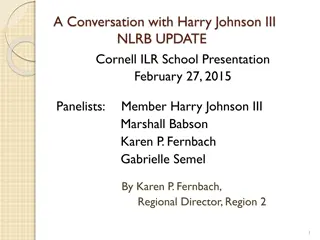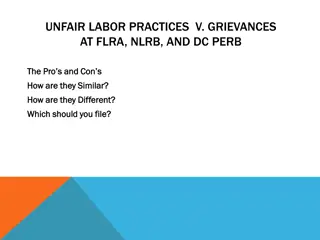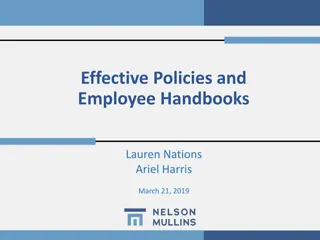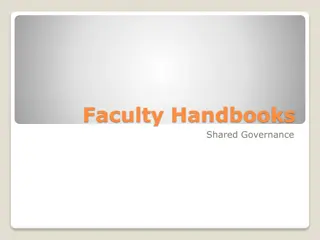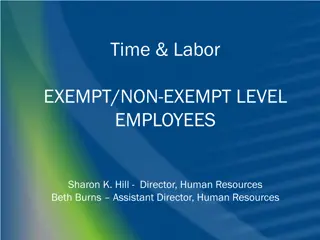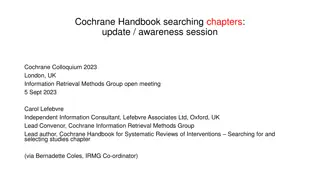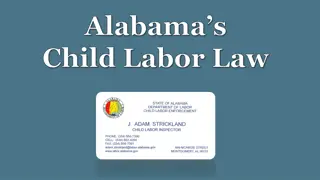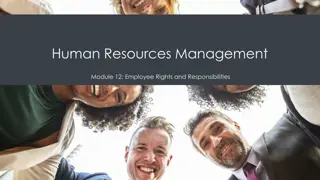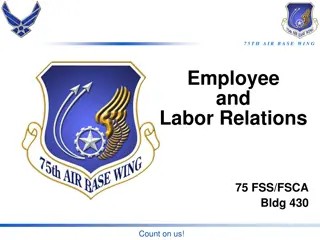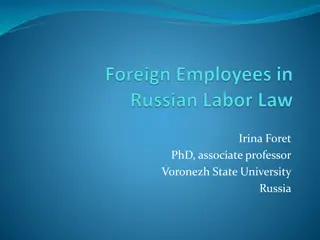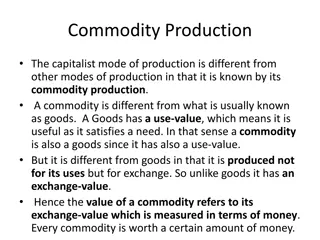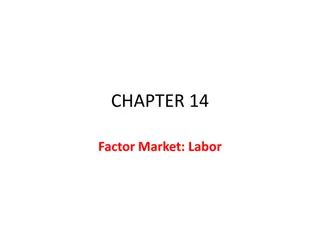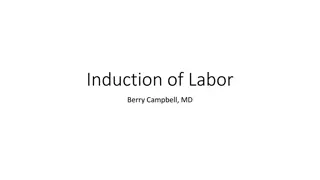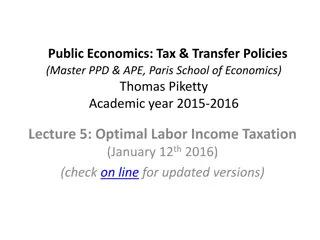Understanding NLRB Rules and Employee Handbooks in Labor Law
Labor and employment seminar discussing the impact of National Labor Relations Board (NLRB) rules on personnel policies, social media, workplace behavior, confidentiality, and more. Learn about the composition of the NLRB board, handbook interpretations, and the importance of aligning current policies with the NLRB standards.
Uploaded on Sep 10, 2024 | 0 Views
Download Presentation

Please find below an Image/Link to download the presentation.
The content on the website is provided AS IS for your information and personal use only. It may not be sold, licensed, or shared on other websites without obtaining consent from the author. Download presentation by click this link. If you encounter any issues during the download, it is possible that the publisher has removed the file from their server.
E N D
Presentation Transcript
2018 Labor and Employment Seminar Paul J. Zech Felhaber Larson 220 South 6th Street, Suite 2200 Minneapolis, MN 55402
Personnel Policies Under the New NLRB
Summary New NLRB rules on handbooks Focus on specific policies Social media Workplace behavior and civility Confidentiality Other specific developments Joint Employer Picketing Union organizing and solicitation
What is the NLRA/NLRB? NLRA impacts union and non-union workplaces other concerted activities for the purpose of . . . mutual aid or protection. NLRB oversees and enforces labor law. Both protect and govern union and non-union workplaces.
Board Composition Marvin Kaplan (R) Member Term Expiration August 27, 2020 Lauren McFerran (D) Member Term Expiration December 16, 2019 Peter Robb (R) General Counsel Confirmed November 8, 2017 4-year term John Ring (R) Chair William Emanuel (R) Member Term Expiration August 27, 2021 Term Expiration December 16, 2022
EMPLOYEE HANDBOOKS Handbook Interpretation (GC 18-04) o Ambiguities in handbook rules are no longer interpreted against the drafter. o General provisions interpreted narrowly, not as banning all activity that could conceivably be included. 6
EMPLOYEE HANDBOOKS Handbook Interpretation (GC 18-04) o A neutral rule does not render protected activity unprotected. o Application of facially neutral rule against employees engaged in protected activity remains unlawful. 7
EMPLOYEE HANDBOOKS Takeaway: o Current handbook and personnel policies as closely as the Obama-era Board. NLRB will not scrutinize 8
EMPLOYEE HANDBOOK RULES o Background: The Boeing Company,365 NLRB NO. 154 (DEC. 14, 2017) created new test for interpreting lawfulness of policy. 9
EMPLOYEE HANDBOOK RULES Previous test: a workplace policy was unlawful if an employee would reasonably construe the rule to restrict protected concerted activity. NewBoeingtest: balance two factors to determine legality: 1. The rule s potential impact on protected concerted activity; and 2. The employer s legitimate business justification(s) for the rule. 10
EMPLOYEE HANDBOOK RULES GC Memo 18-04 o Provided clarity regarding NLRB s view on many handbook provisions o Created three categories of rules: Category 1: generally lawful rules Category 2: case-by-case scrutiny of rule Category 3: generally unlawful rules 11
EMPLOYEE HANDBOOK RULES Category 1 Rules o 9 generallylawful policies 1. Civility: Can prohibit disparagement of other employees. 2. No Photography/Audio/Video Recording: Can prohibit employees from using camera or recording device at work (does not mean employers can ban all phone use/possession). 12
EMPLOYEE HANDBOOK RULES Category 1 Rules 3. Insubordination: Can prohibit employee insubordination or improper conduct that adversely affect operations. 4. Disruptive Behavior: Can ban conduct causing disruptions during work hours (not including strikes or walkouts). 13
EMPLOYEE HANDBOOK RULES Category 1 Rules 5. Protecting disclosure of proprietary, confidential, and customer information. Confidentiality: Can prohibit 6. Defamation or Misrepresentation: Can prohibit communications that are defamatory or that misrepresent company products, services, or employees. 14
EMPLOYEE HANDBOOK RULES Category 1 Rules 7. Use of Employer Logos: Can ban employee use of company logo for non-business purposes. 8. Employer Authorization to Speak for Company: Can ban employees from speaking for company in person or on social media. 9. Disloyalty, Nepotism, or Self-enrichment: Can prohibit employees from competing with, exploiting position with, or interfering with company. 15
EMPLOYEE HANDBOOK RULES Category 2 Rules o These rules are evaluated on case by case basis individualizedscrutiny o Balance employee v. employer interests 16
EMPLOYEE HANDBOOK RULES Category 2 Rules o Examples: o Broad Conflict-Of-Interest Rules: Where the rules do not specifically target fraud and self-enrichment, they will be scrutinized. o Confidentiality Rules: Broad rules encompassing employer business or all employeeinformation may infringe on protected Section 7 rights. o Anti-Disparagement Rules: Rules regarding disparagement or criticism of the employer should be scrutinized (unlike criticism of employees). 17
EMPLOYEE HANDBOOK RULES Category 2 Rules o Rules Regulating Use of the Employer s Name: these rules will be highly scrutinized (unlike using company s logo, which may be protected). o Rules Prohibiting Speaking to the Media: Will be scrutinized (unlike speaking on employer sbehalf, which can be banned). 18
EMPLOYEE HANDBOOK RULES Category 2 Rules o Off-Duty Conduct Rules: Will depend on which conduct is being regulated. o Rules Generally Prohibiting False Statements: Will be highly scrutinized defamatory statements, which are lawful). (unlike rules against 19
EMPLOYEE HANDBOOK RULES Category 3 Rules o Presumptively Unlawful o Examples: Cannot prohibit disclosure of wage, salary, benefit, working conditions. Cannot prohibit organizations (i.e. unions). joining outside 20
EMPLOYEE HANDBOOK RULES Takeaways o These interpretations and rule changes represent a dramatic change. o Several of these now-lawful rules were expressly banned under previous Board interpretations. Examples: Photo/video recording at work; use of employer logo; confidentiality. 21
FOCUSON SPECIFIC POLICIES Social Media -- NLRB Position: o Federal law give all employees the right to join together online. o Using social media can be a form of protected concerted activity. o Employees have right to address work-related issues and share information about pay, benefits, and working conditions with coworkers online. 22
FOCUSON SPECIFIC POLICIES Social Media -- NLRB Position: o But, individually griping about some aspect of work is not concertedactivity o To be protected, social media activity must have some relation to group action, or seek to initiate, induce, or prepare for group action, or bring a group complaint to the attention of management. 23
FOCUSON SPECIFIC POLICIES Social Media North West Rural Electric Coop., 366 NLRB No. 132 (July 19, 2018). Employee fired for posting on Facebook group comments critical of employer s safety practices. Employer cited conduct and attitude policies as rationale. NLRB sided with employee, holding that neutral policies cannot be applied to suppress worker rights. 24
FOCUSON SPECIFIC POLICIES Workplace Behavior and Civility Mexican Radio Corp., 366 NLRB No. 65 (2018): Employee quit by sending profane, opprobrious email to coworkers, management, and owners about employer s management style and business practices. Four employees responded to group email in agreement to the complaints. These four employees were each interviewed and terminated for violating company insubordination and behavior policies. 25
FOCUSON SPECIFIC POLICIES Workplace Behavior and Civility Mexican Radio Corp., 366 NLRB No. 65 (2018): NLRB: Employees engaged in protected activity by responding to the emails Emails were private and did not harm company reputation or cause disruption. Employer unlawfully applied neutral workplace policy to terminate employees. 26
FOCUSON SPECIFIC POLICIES Workplace Behavior and Civility Examples of lawful civility policies: Conduct that is inappropriate or detrimental to patient care or hospital operation, or that impedes harmonious interactions and relationships, will not be tolerated. Behavior that is rude, condescending, or otherwise socially unacceptable is prohibited. Disparaging the company s employees is prohibited. 27
FOCUSON SPECIFIC POLICIES Confidentiality Dura-Line Corp., 366 NLRB No. 126 (2018) Employer forced to close plant and relocate. Sought to transfer several employees to new location. Employer presented non-disclosure agreement (NDA) to selected employees, which prohibited sharing of confidentialinformation with third parties. Confidential information included relocation plans, wages, or job at new plans. 28
FOCUSON SPECIFIC POLICIES Confidentiality Dura-Line Corp., 366 NLRB No. 126 (2018) Employee challenged NDA as intended to prevent union activity. NLRB upheld NDA. Held that employer had legitimate concerns about controlling timing and disclosure of relocation news. 29
FOCUSON SPECIFIC POLICIES Confidentiality Examples of lawful confidentiality policies: Information concerning customers shall not be disclosed, directly or indirectly, or used in any way. Do not disclose confidential financial data, or other non-public proprietary company information. Do not share confidential information regarding business partners, vendor, or customers. 30
FOCUSON SPECIFIC POLICIES BUT, confidentiality has its limits. Costco Wholesale Corp., No. 366 NLRB No. 9 (2018): After workplace employee interviews. Costco told employee not to have any conversations with anyone else pertaining to this incident. NLRB: Employer must demonstrate its need for confidentiality outweighs harm to employee s rights. Costco did not explain need, so violated NLRA. altercation, Costco conducted 31
FOCUSON SPECIFIC POLICIES BUT, confidentiality has its limits. Colorado Symphony Ass n, 366 NLRB No. 122 (2018): Employer insisted that union sign a confidentiality agreement that included a monetary damages clause. Union objected to monetary damages clause. NLRB: Damage clause unlawful because employer had no basis for believing union would violate agreement. Therefore, not reasonable to dispel confidentiality concerns. 32
OTHER SIGNIFICANT DEVELOPMENTS Joint Employer New rule proposed September 2018 An employer may be considered a joint employer of a separate employer s employees only if the two employers share or codetermine the employees essential terms and conditions of employment, such as hiring, firing, discipline, supervision, and direction. A putative joint employer must possess and actually exercise substantial direct and immediate control over the employees essential terms and conditions of employment in a manner that is not limited and routine.
OTHER SIGNIFICANT DEVELOPMENTS Joint Employer Proposed rule intended to foster predictability, consistency and stability. Rule is very rigid. Even direct and immediate control may not satisfy standard if the control is limited in scope and does not include essential terms. Rule currently in comment period.
OTHER SIGNIFICANT DEVELOPMENTS Picketing Ortiz Janitorial Services, 366 NLRB No. 159 (2018): Janitors employed by subcontractor to provide cleaning services for company. They picketed at company s building, which was managed by third- party. Janitors sought increased wages and remediation of harassment. NLRB held the protests were secondaryactivities not protected by NLRA.
OTHER SIGNIFICANT DEVELOPMENTS Picketing Ortiz Janitorial Services, 366 NLRB No. 159 (2018): Board found that object of protests was the building manager, not just employer. Goal was to disrupt business relationship between them. Takeaway: NLRB taking close look at secondary picketing and picketing sites where multiple companies share office space.
OTHER SIGNIFICANT DEVELOPMENTS Picketing Capital Medical Ctr., 2018 U.S. App. LEXIS 22395 (D.C. Cir. Aug, 10, 2018): Off-duty hospital employees picketing at non-emergency hospital entrance. No chanting, marching, or obstruction. NLRB held, and DC Circuit affirmed, that picketing was lawful because hospital could not show that removal of picketers was necessary to prevent patient disturbance.
OTHER SIGNIFICANT DEVELOPMENTS Picketing NLRB GC Memo 18-02 in December 2017. Signaled intent to revisit off-duty picketing issue. May expand employer rights to control picketing on property, particularly where employer has legitimate safety interest (i.e. hospital s interest in patient care).
OTHER SIGNIFICANT DEVELOPMENTS Union organizing and member solicitation UPMC, 366 NLRB No. 142 (2018): Employer s solicitation and distribution policy prohibited off-duty employees from soliciting or being solicited in non-work areas during non-work time. NLRB struck down policy because it banned union activity without being necessary to avoid disruption of healthcare operations.
OTHER SIGNIFICANT DEVELOPMENTS Union organizing and member solicitation Seven Seas Union Square, LLC, 2018 NLRB LEXIS 79 (2018): ALJ decision. Employee challenged employer s rules prohibiting workplace solicitation, loitering, and political activities. ALJ: Non-solicitation rule is a category-3 practice and unlawful. No-politics rule is a category-2 rule and unlawful, since politics certainly incorporates . . . protected activity. Loitering rule is a category-2 rule and lawful. 40
OTHER SIGNIFICANT DEVELOPMENTS Repudiating Unlawful Policy TBC Corp., 367 NLRB No. 18 (2018): Employer issued a handbook policy that banned solicitation on company property during non-work hours. Policy was unlawfully overbroad, and employer voluntarily changed policy by distributing and posting a notice to employees at all stores of the repudiated policy. ALJ found employer s repudiation ineffective because it did not explain the reasons for changing the policy. 41
OTHER SIGNIFICANT DEVELOPMENTS Repudiating Unlawful Policy TBC Corp., 367 NLRB No. 18 (2018): NLRB reversed, holding there was no violation. NLRB explained: Employer s are not required to explain why they are repudiating an unlawful policy. It is sufficient for employers to amend the handbook and notify the affected employees of the new rules. Takeaway: Company can save time and money by clearly following NLRB notice procedures for repudiating unlawful policy. 42
FORECASTED CHANGES Workplace computer use for personal purpose NLRB issued notice and invitation to file briefs in Caesars Entertainment Corp. Case seeks to overrule Purple Communications, Inc. standard governing whether and how employers can prohibit use of its computer resources (i.e. emails) to send non-business information. A finding for Caesars would allow employers to impose Section 7-neutral restrictions. 43
FORECASTED CHANGES GC recently released four Obama-era GC advice memos. May signal current Board s plan to address these issues. Issues include employer s ability to: direct worker to take off union t-shirt; prohibit night-shift workers form wearing union insignia; permanently replace striking workers; take photos of union solidarity marches Also includes difference between legal on-site work stoppage and illegal sit down strike. 44
SUMMARY New NLRB is taking employer-friendly stances on many workplace issues. This may change the way that employers create and enforce workplace personnel policies. Specifically, employers have more leeway in crafting policies that ban category 1 activities. 45
SUMMARY However: Employers must closely tailor the policies to workplace needs. Overbroad policies may be deemed unlawful. Employers must neutrally enforce the policies to avoid violating employee rights. Social media activities still closely monitored and may be deemed protected activity depending on the content and platform. 46
SUMMARY Follow NLRB decisions to see how Board interprets and applies the personnel policy rules discussed in the GC Memos. Forecasted changes coming for: Joint employer rule Workplace computers for personal purpose Workplace clothing and insignia Camera and photo use Picketing 47
PRACTICE TIPS 1. Review current personnel policies to identify rules that could be strengthened to protect legitimate employer interests. 2. Rewrite policies that run the risk of being overbroad. Tailor each rule to interests that NLRB has deemed valid. Consider including examples of prohibited behavior to avoid risk of overbreadth. 3. Ensure no rules prohibit arguably protected activity under the NLRA. This includes rules on private off-duty email, social media use, and conduct. 4. Train management, supervisors, and human resources on how to deal with employee disputes. This will safeguard a company from the risk that policies are applied unequally and deemed invalid. 48
PRACTICE TIPS 5. Outline clear procedures for reporting workplace violations. Work with different levels of company to ensure that reporting mechanisms will be utilized and effective. 6. Include conspicuous disclaimers in the handbook. This may include disclaimers that the handbook is not a contract, contains no guarantees, and may be amended by the employer at any time without company. This may require union approval. 49
QUESTIONS? Thank you! 50


